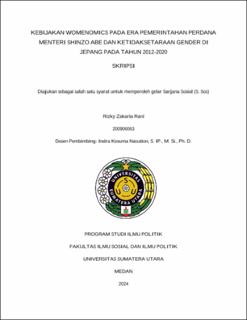Kebijakan Womenomics pada Era Pemerintahan Perdana Menteri Shinzo Abe dan Ketidaksetaraan Gender di Jepang pada Tahun 2012-2020
| dc.contributor.advisor | Nasution, Indra Kesuma | |
| dc.contributor.author | Rani, Rizky Zakaria | |
| dc.date.accessioned | 2024-11-20T07:24:50Z | |
| dc.date.available | 2024-11-20T07:24:50Z | |
| dc.date.issued | 2024 | |
| dc.identifier.uri | https://repositori.usu.ac.id/handle/123456789/98997 | |
| dc.description.abstract | This thesis aims to describe the condition of gender inequality against women in Japan during Prime Minister Abe’ administration after the implementation of womenomics policies in various sectors, especially labor and economy. Data were collected using descriptive qualitative method with literature study through research journals, books, government reports or whitepapers, Goldmansachs and Global Gender Gap Index reports, websites, news and proceedings which were then collected, classified and sorted. The results of this study show that despite the success of womenomics policies in increasing women's participation in the labor sector, the level of gender inequality and gender gap still often occurs in various sectors such as the economy , workforce and politics due to a strong patriarchal and conservative culture. | en_US |
| dc.language.iso | id | en_US |
| dc.publisher | Universitas Sumatera Utara | en_US |
| dc.subject | policy implementation | en_US |
| dc.subject | womenomics | en_US |
| dc.subject | gender | en_US |
| dc.title | Kebijakan Womenomics pada Era Pemerintahan Perdana Menteri Shinzo Abe dan Ketidaksetaraan Gender di Jepang pada Tahun 2012-2020 | en_US |
| dc.title.alternative | Womenomics Policies During the Era of Prime Minister Shinzo Abe's Administration and Gender Inequality in Japan in 2012-2020 | en_US |
| dc.type | Thesis | en_US |
| dc.identifier.nim | NIM200906063 | |
| dc.identifier.nidn | NIDN0006037901 | |
| dc.identifier.kodeprodi | KODEPRODI67201#Ilmu Politik | |
| dc.description.pages | 119 Pages | en_US |
| dc.description.type | Skripsi Sarjana | en_US |
| dc.subject.sdgs | SDGs 5. Gender Equality | en_US |
Files in this item
This item appears in the following Collection(s)
-
Undergraduate Theses [1110]
Skripsi Sarjana


